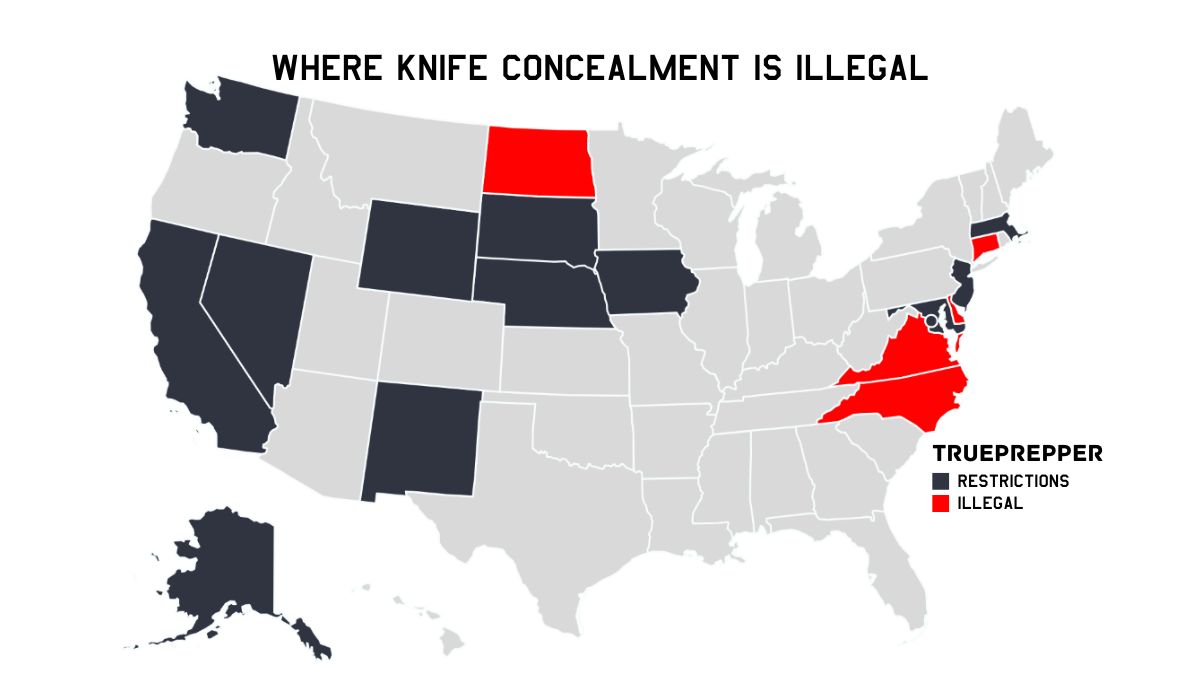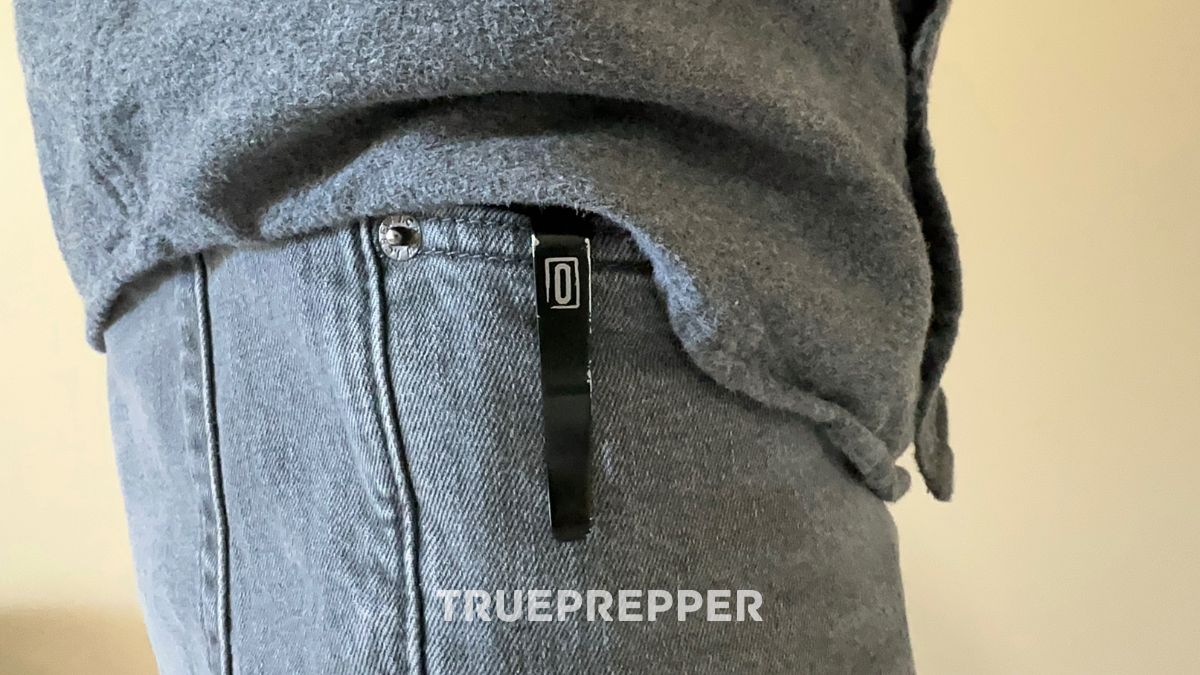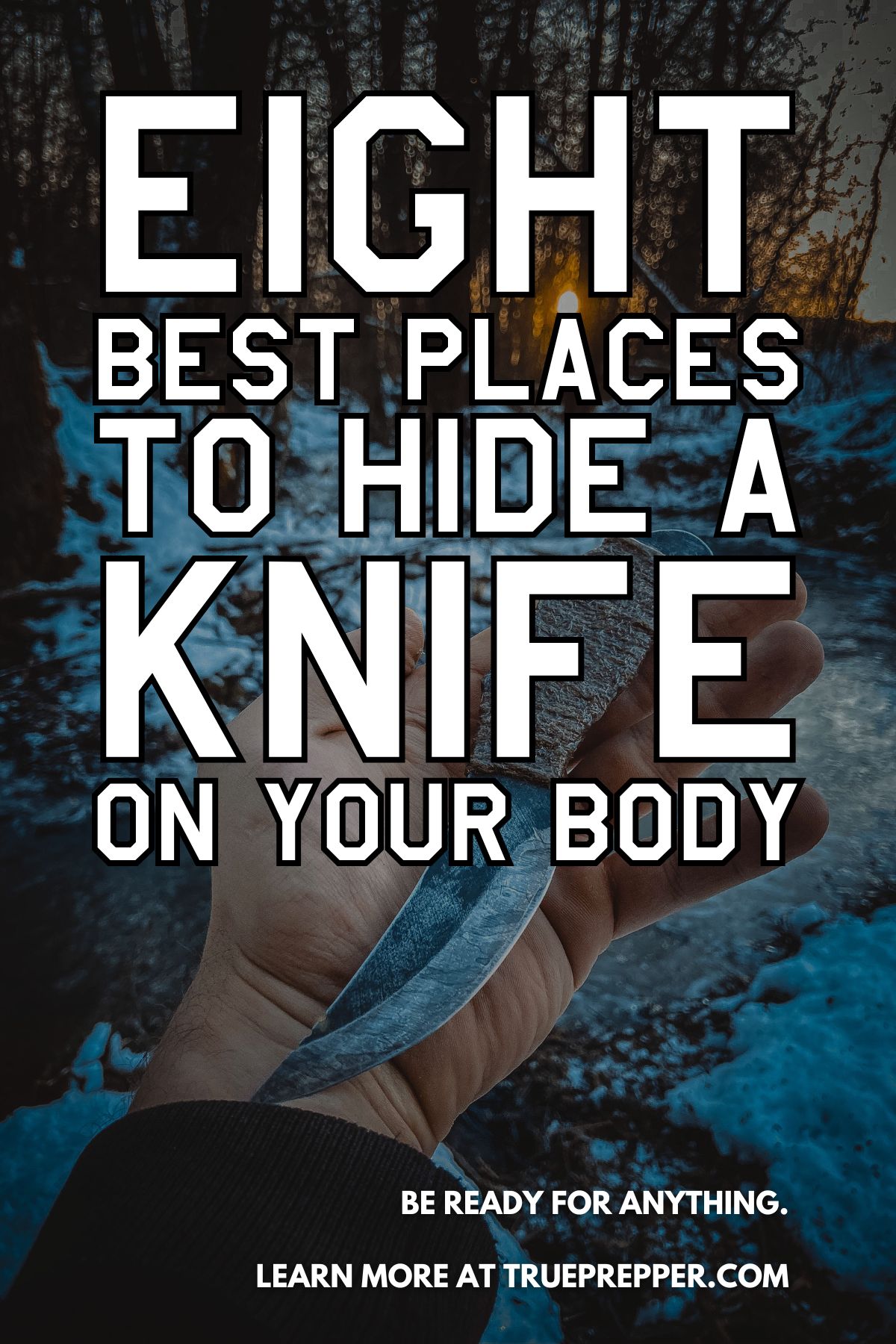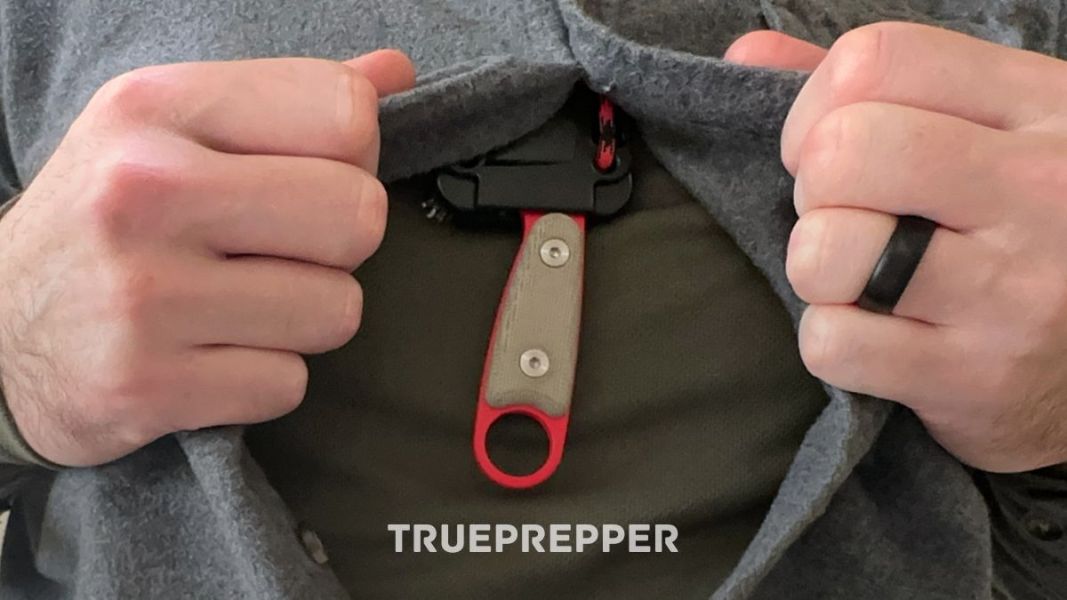Hide a Knife – 8 Best Places to Conceal on Your Body
Hidden knives within reach have altered the course of history. While things might not be that dramatic for you, a well-placed knife can indeed give you a fighting chance in a bad situation. It can also help you get some work done while staying discrete the rest of the day. There are only a few drawbacks when you hide a knife on your body, like safety and legal concerns.
The trick is finding a place on your body that is out of sight. There are several places to pick from- all with their advantages and disadvantages. You’ll know when you’ve found the right spot- it will feel natural and comfortable while giving you a leg up in everyday preparedness.
Contents (Jump to a Section)
Concealing a Knife
With my rapidly growing knife collection, I’m always looking for ways to put them to use. While the folders are easy to carry concealed in a pocket, the larger fixed-blade knives pose a problem when I need to hide a knife on my body.
Just like a concealed carry pistol, I’m not trying to broadcast to the world any intentions with my knives. I don’t stroll up and down the street like Crocodile Dundee saying “This HERE is a knife”. Well, usually I don’t.
Instead, I prefer to stick to gray man principles and keep things discrete. Luckily, there are a ton of options when it comes to hiding a knife on your body. You can pick a different spot each day of the week and have a few left over.
Quick Note: Many of these knife concealment methods can be dangerous. Be practiced and familiar with any carry method you use and know the risks.
We’ll go through some red tape and then start with my personal favorite: the horizontal carry.
Are Concealed Knives Illegal?
There are no federal laws on whether concealed knives are legal in the United States, so the rules fall to the states.
Many states have specific laws about blade size and opening action (like switchblades), but concealment is a different animal. Here are the states you’ll need to do your homework:
- Connecticut – Concealed carrying of dangerous weapons is prohibited, and most knives can be interpreted as dangerous weapons.
- Delaware – Concealed carry of ‘deadly weapons’ is illegal, and most knives except ‘typical pocket knives’ are considered deadly weapons. Plenty of interpretation room here for the jury/judge.
- North Carolina – This is where I live and knife laws are extremely restrictive, especially for concealment. Concealment even in your pocket is illegal and the specifics are often left up to a jury to debate whether a clip showing on a small folding knife counts as concealment or not.
- North Dakota – It’s a Class A misdemeanor to conceal carry a knife except for folders less than 4″ blade length.
- Virginia – Most knives are illegal to conceal, except for some folders.
Even beyond the states, many local municipalities, businesses, and government buildings (especially schools!) have their own laws on concealed knives.
Disclaimer: We are not lawyers and do not share legal advice. Investigate your local regulations on your own or seek legal counsel concerning rules and laws in your jurisdiction.

Horizontal Carry Belt Sheath
Putting a sheath horizontal on your belt is the most popular option and allows for easy access.
This method is usually called the ‘scout carry’. You can put it anywhere you can fit it on your belt, as long as it is parallel it fits the bill. But most people prefer it on the center of their back, especially with larger blades.
You can easily reach the knife in this position, but it also conveniently is covered by shirts and jackets.
Here is Beau showing off not only my favorite carry position but also a smaller version of our top-reviewed survival knife.
CCW Off-Hand
If you carry a CCP, this knife placement is usually recommended. This is clipped inside your pants/belt opposite of your draw side.
We go more into the pros and cons in our review of a specific CCW knife, the KA-BAR TDI Law Enforcement Knife.

The main point is that this knife is meant to stop anyone from reaching your concealed carry firearm. Knives designed for this have this placement in mind and include short talon-like blades. They are lightweight and it’s easy to forget you have them there during everyday tasks.
Up a Sleeve or On the Arm
Out of all of the options, this is the most difficult to execute but it is like something straight out of a spy movie. There are a few ways you can go about getting it done, and they all require long sleeves for concealment:
- Strap the sheath to your arm: Use straps integrated into the sheath or your own to strap the sheath on your forearm with the hilt towards your hand and reachable close to the opening of your sleeve.
- Strap the sheath to your garment: Whether it’s inside your shirt or jacket, you can attach your knife sheath on the inside of the sleeve with a few sewn-in straps. Orient the sheath on the forearm area with the hilt towards the hand opening, close enough for the hilt to be reached.
- Tie the sheath with a remote-release: Use a remote-release knot to hold the sheath in place anywhere on your arm where it does not impede your movement. When you need the knife, pull the remote-release strand to drop the sheathed knife down your sleeve and into your same hand.
Yeah, the last one sounds like something from a Jason Bourne movie but it is possible if you want to go through the hassle of tying it up. Out of all of the ways to hide a knife, this is the most difficult but can also be the most surprising.
In the Pocket
The most common place to conceal a knife is in your pocket. Most folding knives are carried in a pocket, and when they’re in there most states consider them concealed! Clipping it to your pocket with the clip visible can bypass that in a few states, and a few states dismiss them as common pocket knives if the blade length isn’t too big.

Many people don’t consider a pocket knife as a concealed weapon, but your state or local legislature might. As far as hiding a knife goes, it’s so common that a pocket is not a great place to hide anything. Pat downs typically check the pockets for a reason- it’s a convenient and predictable place to stash stuff, including knives.
Boot Clip or Ankle Wrap
The boot knife concealment option is a popular pick for backup blades and self-defense.
In the 1800s this was called the gamblers dagger, and as you would guess it was used to confront cheaters (or by cheaters to protect themselves).
These days it is still popular in the military, law enforcement, and with hunters. You can even fit larger knives as boot knives, making it an ideal carry spot for combat or field dressing.
Boot Laces
Lacing a knife onto your boots or shoes is relatively easy, and a better concealment option than you might think.
It takes a bit of work to get it in there snugly and then re-lace your boots to be tight. Just make sure you don’t lace over the pommel or have them get in the way of any guard. The best knives for boot laces are short and usually guardless anyway.
Neck Knife
A survivalist favorite, the neck knife is a sheathed knife you carry as a necklace. Usually, they are very small fixed blades since they are dangling around your neck by a piece of cord.
Vikings and Native Americans both used the neck knife carry position, but to conceal it you’ll need to tuck it under your shirt. This may cause delays when you need to access it, so this position is better for task work rather than self-defense.
If it’s good enough for humans all the way through prehistory, it’s a good enough option for me. You can check out our full review of the best neck knives:

Shoulder Sheath
The underarm shoulder sheath is just like it sounds and similar to the CCW placement often seen in gangster and detective movies. It is a great concealed option that isn’t tough to access quickly. It’s great when you’re wearing a jacket or unbuttoned shirt since the harness itself will also be covered.
X4CTO shows several knife concealment methods, but does an excellent job demonstrating the under-arm shoulder sheath:
Where NOT to Put a Knife
Two of the worst places to try to carry a knife are on your backpack shoulder strap and on the same side as your CCP.
A backpack shoulder strap is a popular option for TV shows, movies, and video games since it shows that the character is adventurous enough to display their knife proudly and have it reached at a moment’s notice.
The severe drawback to this placement is that with any surprise altercation, your own withdrawn knife is pointed at your throat. It is also prominent and on display, making it difficult to not draw unwanted attention.
Putting your knife on the same side of your CCP is just asking to fumble around for it or your firearm. You want a clean draw for both- so don’t go jamming everything on one side to save space.
One place not on our list is drop-leg on either side. This is because this is a tough spot to conceal or hide a knife, not because it is a bad spot.
The Final Word
Knives are great tools for survival and self-defense. If you need to hide a knife on your body there are plenty of spots to pick from. If I missed your favorite spot, let me know in the comments.
Here are some other popular guides our subscribers have found helpful:
- The Best Concealed Carry Pistol for a Defensive Prepper
- The Best Survival Knife with a Fixed Blade
- Everyday Carry List | 25 EDC Essentials
Keep exploring, stay prepared, and be safe.
You’ve Been Missing Out
Join the 2+ million preppers that rely on our prepping advice by subscribing to TruePrepper.- Practical guides and tips
- Useful survival giveaways
- Free, forever
- < 0.4% of people unsubscribe


